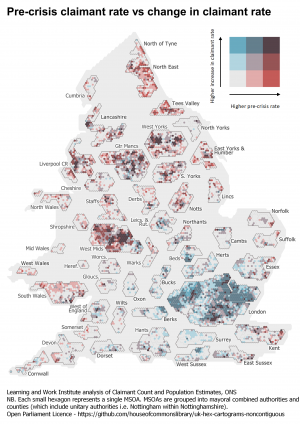May 2021
The labour market has stabilised and is showing signs of recovery with vacancies rising and payroll employment increasing again
Employment rose by 84,000 in January to March 2021 compared to the previous quarter and is 529,000 lower than a year ago. The timelier measure of PAYE employees has risen by 97,000 in April 2021 compared to the previous month, and is 737,900 lower than in March 2020 (257,000 lower than in April 2020).
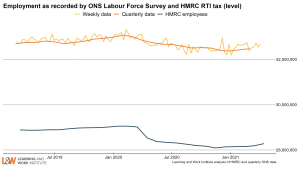
Unemployment is 258,000 higher than a year ago, but 121,000 lower in January to March 2021 than in the previous quarter. The number of people claiming unemployment-related benefits fell by 15,100 in April 2021 compared to the previous month, to stand at 2.63 million.
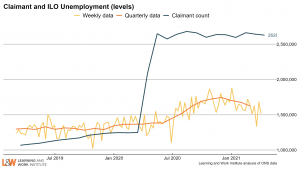
After a sharp initial impact in spring 2020, there have been smaller changes in employment and unemployment overall than would be expected given the fall in economic output. We estimate unemployment would be around 2.5 million higher had it followed the path of economic output.
The number of online vacancies as measured by Adzuna fell two thirds during the spring 2020 lockdown but is now above its pre-crisis levels. However, there is significant sector variation. While hospitality vacancies have risen ahead of planned reopenings and transport, logistics and warehouse vacancies are significantly up since the start of the pandemic; retail vacancies are still down.
The number of hours worked is also recovering, but remains below pre-pandemic levels as the furlough scheme protects jobs
The furlough scheme and other economic support have protected millions of jobs. Instead, more of the labour market adjustment to the crisis has come in people working fewer hours, including those who were furloughed. The latest data show the total number of hours worked returned to 93% of the February 2020 level at the end of April after an earlier reduction during the November-March lockdowns.
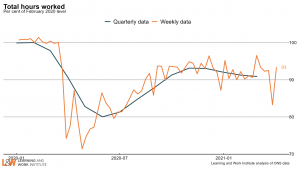
This reflects the end of the latest lockdown. The number of people furloughed rose to 4.6 million in February 2021, compared to 4 million in December 2020, but had fallen to 4.2 million at the end of March 2021 (of whom 2.9m were fully furloughed). The latest data show the number of people temporarily away from work is 1.8 million above its pre-pandemic level, suggesting a further fall in the number of people furloughed. 1.49 million have been away from work for 3 months or more, 1.06 million higher than normal. Those who have been away from work the longest are at highest risk of longer-term effects.

Young people continue to be among those hardest hit
Young people account for 73% of the fall in employment, despite accounting for just 12% of total employment. As a result, the number of unemployed 16-24 year olds has risen 13,000 over the last year and 502,900 18-24 year olds are claiming unemployment-related benefits, double pre-crisis levels.
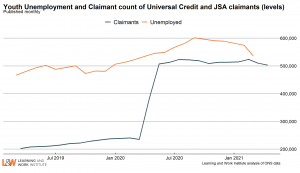
The number of young people unemployed for 6 months or more has fallen back this month. There were 212,000 long term unemployed young people in January to March 2021, up 8% on the previous quarter, and 41% on a year before.

We continue to argue for a Youth Guarantee to ensure all 16-24 year olds are offered a job, training place or apprenticeship. That includes for the 500,000 young people estimated to be leaving full-time education this summer.
Unemployment has risen most in places where it was already high, creating a challenge for the Government’s ambition of levelling up
The Government plans to launch a White Paper later this year setting out what it means by levelling up and how it plans to deliver this.
There have been large and persistent inequalities in employment and incomes between people living in different parts of the country, as well as between different demographic groups. Narrowing these inequalities should form an important part of levelling up.
The latest data confirm that the proportion of people claiming unemployment-related benefits has risen fastest since the start of the pandemic in areas where it was already high. Our analysis shows that the proportion of people claiming unemployment-related benefits rose three times faster in areas with higher pre-crisis claimant rates than in areas with the lowest rates.
